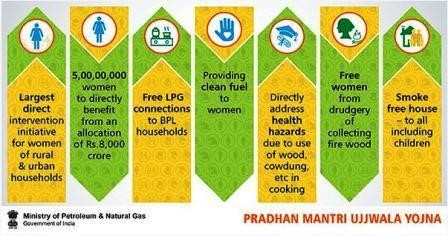THE IMPACT OF PRADHAN MANTRI UJJWALA YOJANA IN JAMMU AND KASHMIR
Syllabus:
GS 2 – Welfare schemes for vulnerable sections of the population by the Centre and States and the performance of these schemes
Why in the News?
- In Jammu & Kashmir, 85.07% of households have LPG connections.
- Nearly 68% of these LPG connections were provided under the Pradhan Mantri Ujjwala Yojana (PMUY).
- Expansion of LPG distribution points in rural areas is being considered to increase clean fuel adoption.
- Financial support for LPG refills is also proposed to make clean fuel more accessible.
Background
- According to the International Energy Agency, approximately 681 million people in India still use solid fuels for cooking, posing significant health and environmental risks.
- The Pradhan Mantri Ujjwala Yojana (PMUY) was launched to encourage clean fuel adoption by providing subsidized LPG connections to economically disadvantaged households.
- To date, the government has distributed 3 crore LPG connections under PMUY.
- A study was conducted to assess the impact of PMUY in the Jammu & Kashmir regions of Kulgam and Rajouri.
- Primary survey data was collected from 820 households across 48 villages in these relatively disadvantaged districts.
- Systematic random sampling was used, selecting 24 villages from each district and covering all tehsils proportionate to their population size.
- The survey included households from different economic categories: Above Poverty Line (APL), Below Poverty Line (BPL), and Antyodaya Anna Yojana (AAY).
- Female household members responsible for cooking were interviewed using comprehensive questionnaires.
LPG Connection Adoption in Rural J&K
- Adoption Rate:07% of rural households in Jammu & Kashmir have official LPG connections, with 68% acquired through the Pradhan Mantri Ujjwala Yojana (PMUY).
- Access Gaps: 4.41% of households, especially in hilly areas like Rajouri, lack access to LPG, while 10.53% rely on unofficial connections.
- Continued Use of Traditional Cooking: Despite increased LPG availability, traditional cooking methods persist.
- 92% of households still have traditional chulhas.
- 85% practice fuel stacking, using both LPG and solid fuels due to cultural ties and affordability concerns.
- LPG Usage: On average, households used 3.56 LPG cylinders in the last six months.
- In Kulgam, PMUY beneficiaries used slightly more (3.54 cylinders) compared to non-PMUY households (3.21).
- In Rajouri, non-PMUY households reported higher usage than PMUY beneficiaries.
- Solid Fuel Consumption: Households still consume about 226 kg of firewood over six months, showing a dual-fuel trend.
Health Impact of PMUY on Women
-
- Objective: A key goal of PMUY is to reduce women’s exposure to indoor smoke from traditional fuels.
- Health Benefits in Kulgam:
- PMUY households report reduced respiratory issues, such as coughing, chest infections, and headaches.
- Among BPL households, coughing incidences dropped from 24% in non-beneficiaries to 21% in PMUY beneficiaries.
- AAY households saw coughing incidents fall from 13% in non-beneficiaries to 10% in beneficiaries.
- Influence of Additional Factors:
- Households with rice cookers or educated members experienced better health outcomes.
- PMUY beneficiaries with rice cookers reported lower coughing rates (20%).
- BPL households where the main cook had secondary or higher education reported just 4% incidence of chest infections
Barriers to Exclusive LPG Usage
1. Lack of Awareness:
- 47% of surveyed households were unaware of the health risks linked to solid fuel use.
- Communication gaps are significant, with 64% of households lacking a TV and 33% reporting that female cooks do not have mobile phones.
- These factors indicate a need for targeted awareness campaigns to educate households on the health benefits of LPG.
2. Financial Constraints:
- The cost of refilling LPG cylinders remains a financial burden for many households, pushing them toward fuel stacking.
- 85% of households continue to use both LPG and solid fuels, highlighting the importance of providing more substantial financial support for LPG refills.
3. Impact of Awareness and Appliance Access:
- Households with higher awareness of LPG’s health benefits report greater LPG usage (3.73 cylinders on average) and reduced firewood use (216 kg).
- Those who do not perceive a taste difference between foods cooked on LPG and traditional fuels tend to rely solely on LPG, averaging 4.27 cylinders in usage.
- Access to appliances like rice cookers is associated with higher LPG consumption, with such households averaging 3.59 cylinders, compared to those without.
4. Recommendations:
- Expanding LPG distribution points in rural areas and providing financial support for refills could further drive the adoption of clean cooking fuel in these communities.
Associated articles
Mains question
“Examine the impact of the Pradhan Mantri Ujjwala Yojana (PMUY) in promoting clean cooking fuel adoption in rural India. Discuss the barriers to exclusive LPG usage and suggest potential solutions.” (Answer in 250 words)






